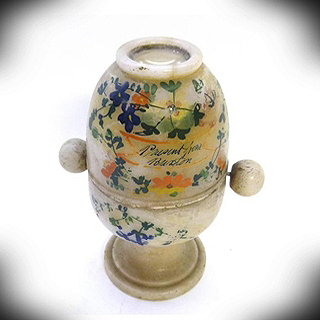Pré Cinema
New in our collection: a Victorian Alabaster peep egg.
Height 127 mm. Present from Buxton, with foliate painted decoration, containing two hand coloured
engraved views of Chatsworth and The Crescent Buxton, and a display of rocks and minerals,
Handles at either side allows the viewer to rotate a spindle to see three or four different views.

.jpg)
Peepshows have their origin in the study of perspective during the 15th and 16th
centuries.
Whilst originally the preserve of the educated, scientists and artists,
by the 18th century peepshows had become a feature of popular street entertainment.
Itinerant showmen travelled the towns and fairs, attracting people by the use of their voices,
musical instruments and sometimes an accompanist.
.jpg)
.jpg)
The mysterious and magical peepshow was but part of the total show which relied strongly
on the showman's story telling abilities.
The showman would also at times create movement by manipulating the images within by use of strings and hooks.
Some types of images allowed the viewer to see the picture as by day,
and then as by night through the use of back-lighting, provided by the sun or a candle.
Popular themes for the peepshows included foreign countries, historical events and nature.
During the 19th century peepshows were also sold as souvenirs, like this peep egg.
Peepshows were popular in many parts of the world and went under several different names: in England and the U.S.A.,
peepshow; in France, boite d'optique; in Italy, mondo nuovo, in Holland, optiques; in Germany, guckkasten.
They were also popular in China and Japan.
%20van%20Kaleidoscope.jpg)
%20van%20Kaleidoscope,vieuw.jpg)
%20van%20Phenakistiscoop.jpg)
%20van%20Voigtlander,%20Daguerro.jpg)
%20van%20Zograscoop.jpg)
%20van%20Zootroop.jpg)